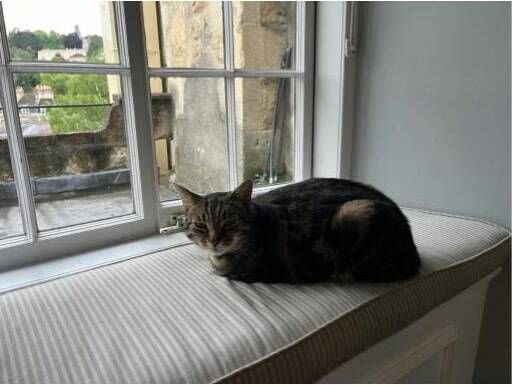Alfie the Cat stretched himself out on a banquette where he’d been gazing out the windows in the hallway of our third floor hotel room. A look-alike for our dearly departed tabby cat, Nile, he welcomed our caresses and rolled himself over for belly rubs. We were staying at the Royal Crescent Hotel and Spa in Bath, England, after a week of walking the Cotswold Way.
“Do you know there’s a cat outside our room?” I asked the hotel staff.
“Oh, that’s Alfie. He lives a few doors down the street, actually. He likes to hang out on the first and third floors.”
“How does he get in?” I asked, thinking of Nile’s secret life, curled up by our Mercer Island neighbors’ wood-burning fireplaces, and returning home smelling of smoke.
“Well, we leave the back door open most of the time, so he just strolls in, and goes up the stairs. People love him. He goes home every night, and his owners know he spends his days here.”
I guess we weren’t the only ones there for pampering.
The city of Bath has been a spa town for thousands of years. The Romans began enjoying its hot springs around 70 CE and stayed for 400 years before abandoning this outpost. During their reign, citizens of all classes mingled in the public baths. Today, the old Roman bathhouse is a museum; no bathing allowed. But there are ways to “take the waters.” $51 will get you into Thermae’s rooftop or indoor pool. Booking either a room or spa services at the 5-star Gainsborough Spa Bath Hotel grants access to their mineral-water pool. And, if you can afford $519 a night before taxes, a totally private experience awaits. The hotel has a few rooms where mineral water pumps right into your tub!
At the Royal Crescent, a beautifully appointed room with turn-down service every evening, a lushly landscaped, spacious garden, award winning restaurant, and spa all exceeded our expectations, even without thermal waters. But the real highlights of Bath were the Georgian architecture, the Holburne Museum, and the parks, shops, restaurants, and cafés of this walkable city. As home to two universities, Bath has dozens of bookshops with knowledgeable, enthusiastic staff. We didn’t need an agenda. Every street had something of interest, and the shop owners we spoke with were happy to make recommendations.
The abundance of Regency-era buildings from the late 1700s and early 1800s earned Bath a UNESCO designation as a World Heritage Site — Bridgerton fans may recognize buildings, shops, and parks from the Netflix smash hit. And UNESCO also lists Bath as “one of the Great Spa Towns of Europe.”
We’d arrived by train from Moreton-in-Marsh, where our previous week’s Cotswolds walk began and ended. Buying the rail tickets online had been confusing – I couldn’t find a station called Bath, but a place called Bath Spa was listed. Huh? Turns out they are one and the same. We got to the Moreton-in-Marsh rail station early. I wanted time to confirm which track was for the 7:40 a.m. train.
“Let me see your tickets,” said the man in the booth. He was listening to an opera and whistling along as he scanned the print-out I handed him.
“Opera fan?” I asked. He didn’t seem to understand. I whistled the aria. “Oh, yes!” he said, smiling broadly. “Makes the time pass…. You’ll need to change trains at Reading,” he added. What? I’d completely forgotten about that. Good thing we’d stopped to talk — our train continued on to London, and we’d have missed our connection.
After settling in our seats with a “cuppa” from the tea cart, I looked at our tickets. Eleven minutes between arrival in Reading and the train to Bath. A tinge of anxiety crept in. Reading is a big, busy rail hub. Would we make it? Whew! Easy-to-understand reader-boards made finding where to go a piece of cake. Or should I say “sponge,” the British term for cake?
Two hours after leaving Moreton-in-Marsh, we’d arrived. A line of cabs waited right outside the station. As the taxi climbed uphill approaching our hotel, I thought something was wrong with my eyes. Instead of a lining up straight, 500 feet of connected houses appeared to be curving in a half-circle. Imagine that — a block of elegant, 250-year-old townhouses, with huge ionic columns on their façades. The whole curvy street is known as The Royal Crescent. Built to provide upper class, 16th century gentry a feeling of “the country in the city” its terraced houses face an enormous park below. Discreetly nestled in the middle of the crescent was our hotel, the perfect place to end our visit to southwestern England. I can’t wait to go back. And maybe Alfie will be there to greet us.
–
Meanderings is a travel column by Mindy Stern, a Mercer Island resident whose essays can be found at www.mindysternauthor.com.


